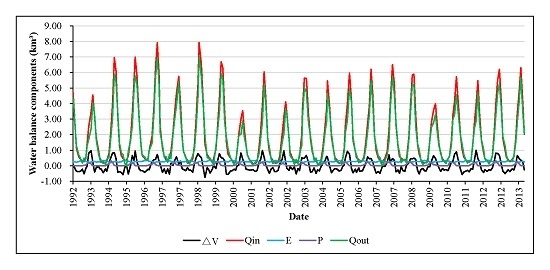Monitoring Recent Fluctuations of the Southern Pool of Lake Chad Using Multiple Remote Sensing Data: Implications for Water Balance Analysis
Abstract
:1. Introduction
2. Study Area
2.1. Lake Chad Setting
2.2. Climatic and Hydrologic Variability
3. Data Source
3.1. Satellite Altimetry Products for Water Level
3.2. Landsat Imagery for Water Surface Area
3.3. Gridded Climate Dataset
3.4. Field Observations
4. Methodology
4.1. Water Surface Mapping
- (1)
- Calculation of MNDWI. As cloud and cloud shadow have already been filtered out from the surface reflectance data, MNDWI can be calculated directly for all the Landsat images available.
- (2)
- Establishment of water mask. For each scene, all pixels with positive MNDWI values are recognized initially as water surface. However, for the whole period from 1991 to 2016, only pixels with a frequency higher than 90% were assumed as water surface. A ten-pixel buffer zone was then created over the continuous water surface and used as the water mask of our study area.
- (3)
- Definition of the MNDWI threshold. Although numerous studies have been conducted to address the threshold of water indexes, how the threshold should be defined is still far from conclusive. It seems that the proper threshold of water indexes is variable for different lakes. Following the manual adjustment procedure by Xu [49] and recommendation by Ji et al. [54], different MNDWI threshold values were tested within the water mask established above. After repeated tests and careful checks on the resulting water body boundary, the threshold value of MNDWI for Lake Chad was set as 0.20.
- (4)
- Extraction of water surface area. Applying the threshold to each Landsat image within the water mask, we obtained the aquatic surface distribution over the study area. The water surface area of the SPLC was extracted by summing up the area of the large continuous pixels identified as aquatic surface.
4.2. Processing of Water Level Products
- (1)
- The accuracy of the altimetry products. Due to the lack of in situ water level observations, it is impossible for us to evaluate the accuracy of these altimetry products directly. In this paper, the accuracy of altimetry products is evaluated indirectly through their correlation with the water surface area extracted above. For a given lake, the relationship between water level and surface area is certain. There should be significant positive correlations between these two variables [55]. Therefore, the Pearson correlation coefficient (r) between the water level and its corresponding surface area was used here to evaluate the accuracy of different altimetry products, and is calculated as:where and are the corresponding water surface area and water level acquired on the same day, respectively.
- (2)
- The inconsistency of the altimetry products. Firstly, the water level retrieved from different altimetry products is referenced to different geoids. Secondly, both GRLM and RLH provide relative water level variations, while the water level retrieved from Hydroweb and DAHITI is presented as an absolute value. These altimetry products need to be transformed into the same reference system so that consistent comparisons can be made. In this paper, this transformation is achieved through a simple offset method, and the WGS84 ellipsoid involved in the DAHITI product is adopted as the universal reference system. Specifically, the offset is determined by averaging the differences between water levels retrieved from DAHITI and those retrieved from other altimetry products. To remove the noise of some outliers, the differences larger than three times the standard deviation have been removed. After the reference system of all altimetry products has been transformed into WGS84 ellipsoid, a direct comparison is conducted to further investigate the accuracy of different altimetry products.
4.3. Water Volume Estimation
4.4. Lake Water Balance
5. Results
5.1. Comparison of Different Altimetry Products
5.2. Water Level Variations
5.3. Lake Surface Area Variations
5.4. Water Volume Variations
5.5. Water Balance of the LAKE
6. Discussion
6.1. Evaluating the Water Budget of the SPLC within the Whole Lake Chad Domain
6.2. Evaluating Present Research in Light of Previous Work
7. Conclusions
Acknowledgments
Author Contributions
Conflicts of Interest
References
- Coe, M.T.; Foley, J.A. Human and natural impacts on the water resources of the Lake Chad basin. J. Geophys. Res. 2001, 160, 3349–3356. [Google Scholar] [CrossRef]
- Lemoalle, J.; Bader, J.C.; Leblanc, M.; Sedick, A. Recent changes in Lake Chad: Observations, simulations and management options (1973–2011). Glob. Planet Chang. 2012, 80–81, 247–254. [Google Scholar] [CrossRef]
- Odada, E.O.; Oyebande, L.; Oguntola, J.A. Lake Chad: Experience and lessons learned brief. Lake Vic. 2005, 92, 75–91. [Google Scholar]
- Birkett, C.M. Synergistic remote sensing of Lake Chad: Variability of basin inundation. Remote Sens. Environ. 2000, 72, 218–236. [Google Scholar] [CrossRef]
- Isiorho, S.A.; Njock-Libii, J. Sustainable water resources management practices in South Chad. Glob. Netw. Environ. Inf. 1996, 11, 855–860. [Google Scholar]
- Lake Chad Untapped Potential; Special Report 97-4; Famine Early Warning System (FEWS), US Agency for International Development (USAID): Washington, DC, USA, 1997.
- Bastola, S.; Francois, D. Temporal extension of meteorological records for hydrological modelling of Lake Chad Basin (Africa) using satellite rainfall data and reanalysis datasets. Meteorol. Appl. 2012, 19, 54–70. [Google Scholar] [CrossRef]
- Lake Chad Basin Commission (LCBC). The Lake Chad Basin. 2014. Available online: http://www.cblt.org/en/lake-chad-basin (accessed on 4 November 2015).
- Luxereau, A.; Genthon, P.; Karimou, J.A. Fluctuations in the size of Lake Chad: Consequences on the livelihoods of the riverain peoples in eastern Niger. Reg. Environ. Chang. 2012, 12, 507–521. [Google Scholar] [CrossRef]
- Leblanc, M.; Favreau, G.; Tweed, S.; Leduc, C.; Razack, M.; Mofor, L. Remote sensing for ground water modelling in large semiarid areas: Lake Chad basin, Africa. Hydrol. J. 2007, 15, 97–100. [Google Scholar]
- Okpara, U.T.; Stringer, L.C.; Dougill, A.J. Lake drying and livelihood dynamics in Lake Chad: Unravelling the mechanisms, contexts and responses. Ambio 2016, 45, 781–795. [Google Scholar] [CrossRef] [PubMed]
- Buma, W.G.; Lee, S.; Seo, J.Y. Hydrological evaluation of Lake Chad Basin using space borne and hydrological model observations. Water 2016, 8, 205. [Google Scholar] [CrossRef]
- Coe, M.T.; Birkett, C.M. Calculation of river discharge and prediction of lake height from satellite radar altimetry: Example for the Lake Chad Basin. Water Resour. Res. 2004, 40, W10205. [Google Scholar] [CrossRef]
- Leblanc, M.; Lemoalle, J.; Bader, J.C.; Tweed, S.; Mofor, L. Thermal remote sensing of water under flooded vegetation: New observations of inundation patterns for the “Small” Lake Chad. J. Hydrol. 2011, 404, 87–98. [Google Scholar] [CrossRef]
- Buma, W.; Lee, S. Investigating the changes within the Lake Chad Basin using GRACE and Landsat imageries. Procedia Eng. 2016, 154, 403–405. [Google Scholar] [CrossRef]
- Lemoalle, J. Application des images Landsat a la courbe bathyme trique du Lac Tchad. ORSTOM Tech. Note Hydrobiol. 1978, 12, 83–87. [Google Scholar]
- Schneider, S.R.; McGinnis, D.F.; Stephens, G. Monitoring Africa’s Lake Chad basin with Landsat and NOAA satellite data. Int. J. Remote Sens. 1985, 6, 59–73. [Google Scholar] [CrossRef]
- Rosema, A.; Fiselier, J.L. Meteosat-based evapotranspiration and thermal inertia mapping for monitoring transgression in the Lake Chad region and Niger Delta. Int. J. Remote Sens. 1990, 11, 741–752. [Google Scholar] [CrossRef]
- Boronina, A.; Ramillien, G. Application of AVHRR imagery and GRACE measurements for calculation of actual evapotranspiration over the Quaternary aquifer (Lake Chad basin) and validation of groundwater models. J. Hydrol. 2008, 348, 98–100. [Google Scholar] [CrossRef]
- Gao, H.; Bohn, T.J.; Podest, E.; McDonald, K.C.; Lettenmaier, D.P. On the causes of the shrinking of Lake Chad. Environ. Res. Lett. 2011, 6, 034021. [Google Scholar] [CrossRef]
- Sarch, M. Fishing and farming at Lake Chad: Overcapitalization opportunities and fisheries management. J. Environ. Manag. 1996, 48, 305–320. [Google Scholar] [CrossRef]
- Sarch, M. Fishing and farming at Lake Chad: Institutions for access to natural resources. J. Environ. Manag. 2001, 62, 185–199. [Google Scholar] [CrossRef] [PubMed]
- Kolawole, A. Cultivation of the floor of Lake Chad: A response to environmental hazard in eastern Borno. Geogr. J. 1988, 154, 243–250. [Google Scholar] [CrossRef]
- Hall, A.C.; Schumann, G.J.P.; Bamber, J.L.; Bates, P.D. Tracking water level changes of the Amazon Basin with space-borne remote sensing and integration with large scale hydrodynamic modelling: A review. Phys. Chem. Earth Parts A/B/C 2011, 36, 223–231. [Google Scholar] [CrossRef]
- Duan, Z.; Bastiaanssen, W.G.M. Estimating water volume variations in lakes and reservoirs from four operational satellite databases and satellite imagery data. Remote Sen. Environ. 2013, 134, 403–416. [Google Scholar] [CrossRef]
- Song, C.Q.; Huang, B.; Ke, L.H. Modeling and analysis of lake water storage changes on the Tibetan Plateau using multi-mission satellite data. Remote Sens. Environ. 2013, 135, 25–35. [Google Scholar] [CrossRef]
- Tong, X.H.; Pan, H.Y.; Xie, H.; Li, F.T.; Chen, L.; Luo, X.; Liu, S.J.; Chen, P.; Jin, Y.M. Estimating water volume variations in Lake Victoria over the past 22 years using multi-mission altimetry and remotely sensed images. Remote Sen. Environ. 2016, 187, 400–413. [Google Scholar] [CrossRef]
- Tilho, J. Variations et disparition possible du lac Tchad. Annales de Géographie. France 1928, 37, 238–260. [Google Scholar]
- Mekonnen, D.T. The Lake Chad Development and Climate Resilience Action Plan (Summary); World Bank Group: Washington, DC, USA, 2016. [Google Scholar]
- Lake Chad Basin Commission (LCBC). Report on the State of the Lake Chad Basin Ecosystem; Deutsche Gesellschaft fur Internationale Zusammenarbeit (GIZ) GmbH: Bonn, Germany, 2016; pp. 29–30. [Google Scholar]
- Jiang, L.G.; Nielsen, K.; Andersen, O.B.; Bauer-Gottwein, P. Monitoring recent lake level variations on the Tibetan Plateau using CryoSat-2 SARIn mode data. J. Hydrol. 2017, 544, 109–124. [Google Scholar] [CrossRef]
- Zhang, G.Q.; Xie, H.J.; Kang, S.C.; Yi, D.H.; Ackley, S.F. Monitoring lake level changes on the Tibetan Plateau using ICESat altimetry data (2003–2009). Remote Sens. Environ. 2011, 115, 1733–1742. [Google Scholar] [CrossRef]
- Birkett, C.M.; Reynolds, C.; Beckley, B.; Doorn, B. From research to operations: The USDA global reservoir and lake monitor. In Coastal Altimetry; Vignudelli, S., Kostianoy, A., Cipollini, P., Benveniste, J., Eds.; Springer: Berlin, Germany, 2011; pp. 19–50. [Google Scholar]
- Crétaux, J.F.; Jelinski, W.; Calmant, S.; Kouraev, A.; Vuglinski, V.; Berge-Nguyen, M.; Gennero, M.-C.; Nino, F.; Cazenave, A.; Maisongrande, P.; et al. SOLS: A lake database to monitor in the Near Real Time water level and storage variations from remote sensing data. Adv. Space Res. 2011, 47, 1497–1507. [Google Scholar] [CrossRef]
- Lemoine, F.G.; Kenyon, S.C.; Factor, J.K.; Trimmer, R.G.; Pavlis, N.K.; Chinn, D.S.; Cox, C.M.; Klosko, S.M.; Luthcke, S.B.; Torrence, M.H.; et al. The Development of the Joint NASA GSFC and the National Imagery and Mapping Agency (NIMA) Geopotential Model EGM96; NASA Goddard Space Flight Center: Greenbelt, MD, USA, 1998; pp. 1998–206861.
- Chander, S.; Majumdar, T.J. Comparison of SARAL and Jason-1/2 altimetry-derived geoids for geophysical exploration over the Indian offshore. Geocarto Int. 2016, 31, 158–175. [Google Scholar] [CrossRef]
- Schwatke, C.; Dettmering, D.; Bosch, W.; Seitz, F. DAHITI—An innovative approach for estimating water level time series over inland water using multi-mission satellite altimetry. Hydrol. Earth Syst. Sci. 2015, 19, 4345–4364. [Google Scholar] [CrossRef]
- Xie, Z.Y.; Huete, A.; Ma, X.L.; Restrepo-Coupe, N.; Devadas, R.; Clarke, K.; Lewis, M. Landsat and GRACE observations of arid wetland dynamics in a dryland river system under multi-decadal hydroclimatic extremes. J. Hydrol. 2016, 543, 818–831. [Google Scholar] [CrossRef]
- Nitze, I.; Grosse, G.; Jones, B.M.; Arp, C.D.; Ulrich, M.; Fedorov, A.; Veremeeva, A. Landsat-based trend analysis of lake dynamics across northern permafrost regions. Remote Sens. 2017, 9, 640. [Google Scholar] [CrossRef]
- Lantz, T.C.; Turner, K.W. Changes in lake area in response to thermokarst processes and climatic in Old Crow Flats, Yukon. J. Geophys. Res. Biogeosci. 2015, 120, 513–524. [Google Scholar] [CrossRef]
- Chen, J.; Zhu, X.L.; Vogelmann, J.E.; Gao, F.; Jin, S.M. A simple and effective method for filling gaps in Landsat ETM plus SLC-off images. Remote Sens. Environ. 2011, 115, 1053–1064. [Google Scholar] [CrossRef]
- Pat, S.; Esad, M.; Gyanesh, C. SCL Gap-Filled Products Phase One Methodology. Available online: http://landsat.usgs.gov/documents/SLC_Gap_Fill_Methology (accessed on 12 April 2006).
- Jang, K.; Kang, S.; Kim, J.; Lee, C.B.; Kim, T.; Kim, J.; Hirata, R.; Saigusa, N. Mapping evapotranspiration using MODIS and MM5 Four-Dimensional Data Assimilation. Remote Sens. Environ. 2010, 114, 657–673. [Google Scholar] [CrossRef]
- Chander, G.; Markham, B.L.; Helder, D.L. Summary of current radiometric calibration coefficients for Landsat MSS, TM, ETM+, and EO-1 ALI sensors. Remote Sens. Environ. 2009, 113, 893–903. [Google Scholar] [CrossRef]
- Harris, I.C.; Jones, P.D.; Osborn, T.J.; Lister, D.H. Updated high-resolution grids of monthly climatic observations—The CRU TS 3.10 Dataset. Int. J. Climatol. 2014, 34, 623–642. [Google Scholar] [CrossRef] [Green Version]
- Harris, I.C.; Jones, P.D. CRU TS3.23: Climatic Research Unit (CRU) Time-Series (TS) Version 3.23 of High Resolution Gridded Data of Month-by-Month Variation in Climate (January 1901–December 2014). 2015. Available online: http://catalogue.ceda.ac.uk/uuid/5dca9487dc614711a3a933e44a933ad3 (accessed on 9 November 2015).
- Bouchez, C.; Goncalves, J.; Deschamps, P.; Vallet-Coulomb, C.; Hamelin, B.; Doumnang, J.; Sylvestre, F. Hydrological, chemical, and isotopic budgets of Lake Chad: A quantitative assessment of evaporation, transpiration and infiltration fluxes. Hydrol. Earth Syst. Sci. 2016, 20, 1599–1619. [Google Scholar] [CrossRef]
- Yang, X.C.; Zhao, S.S.; Qin, X.B.; Zhao, N.; Liang, L.G. Mapping of urban surface water bodies from Sentinel-2 MSI Imagery at 10 m resolution via NDWI-based image sharpening. Remote Sens. 2017, 9, 596. [Google Scholar] [CrossRef]
- Xu, H.Q. Modification of normalized difference water index (NDWI) to enhance open water features in remotely sensed imagery. Int. J. Remote Sens. 2006, 27, 3025–3033. [Google Scholar] [CrossRef]
- Feyisa, G.L.; Meilby, H.; Fensholt, R.; Proud, S.R. Automated water extraction index: A new technique for surface water mapping using Landsat imagery. Remote Sens. Environ. 2014, 140, 23–35. [Google Scholar] [CrossRef]
- Thomas, R.F.; Kingsford, R.T.; Lu, Y.; Cox, S.J.; Sims, N.C.; Hunter, S.J. Mapping inundation in the heterogeneous floodplain wetlands of the Macquarie Marshes, using Landsat Thematic Mapper. J. Hydrol. 2015, 524, 194–213. [Google Scholar] [CrossRef]
- Tulbure, M.G.; Broich, M.; Stehman, S.V.; Kommareddy, A. Surface water extent dynamics from three decades of seasonally continuous Landsat time series at subcontinental scale in a semi-arid region. Remote Sens. Environ. 2016, 178, 142–157. [Google Scholar] [CrossRef]
- Zhu, W.B.; Jia, S.F.; Lv, A.F. Monitoring the fluctuation of Lake Qinghai using multi-source remote sensing data. Remote Sens. 2014, 6, 10457–10482. [Google Scholar] [CrossRef]
- Ji, L.; Zhang, L.; Wylie, B. Analysis of dynamic thresholds for the normalized difference water index. Photogramm. Eng. Remote Sens. 2009, 75, 1307–1317. [Google Scholar] [CrossRef]
- Hendriks, A.J.; Schipper, A.M.; Caduff, M.; Huijbregts, M.A.J. Size relationships of water inflow into lakes: Empirical regressions suggest geometric scaling. J. Hydrol. 2012, 414–415, 482–490. [Google Scholar] [CrossRef]
- Eric, M.; Mohamed, Y.A.; Duan, Z.; Zaag, P. Estimation of reservoir discharges from Lake Nasser and Roseires Reservoir in the Nile Basin using satellite altimetry and imagery data. Remote Sens. 2014, 6, 7522–7545. [Google Scholar]
- Medina, C.; Gomez-Enri, J.; Alonso, J.J.; Villares, P. Water volume variations in Lake Izabal (Guatemala) from in situ measurements and ENVISAT Radar Altimeter (RA-2) and Advanced Synthetic Aperture Radar (ASAR) data products. J. Hydrol. 2010, 382, 34–48. [Google Scholar] [CrossRef]
- Gardelle, J.; Hiernaux, P.; Kergoat, L.; Grippa, M. Less rain, more water in ponds: A remote sensing study of the dynamics of surface waters from 1950 to present in pastoral Sahel (Gourma region, Mali). Hydrol. Earth Syst. Sci. 2010, 14, 309–324. [Google Scholar] [CrossRef] [Green Version]
- Dessie, M.; Verhoest, N.E.C.; Pauwels, V.R.N.; Adgo, E.; Deckers, J.; Poesen, J.; Nyssen, J. Water balance of a lake with floodplain buffering: Lake Tana, Blue Nile Basin, Ethiopia. J. Hydrol. 2015, 522, 174–186. [Google Scholar] [CrossRef]
- Bhang, K.J.; Schwartz, F.W.; Braun, A. Verification of the vertical error in C-Band SRTM DEM using ICESat and Landsat-7, Otter Tail County, MN. IEEE Trans. Geosci. Remote Sens. 2007, 45, 36–44. [Google Scholar] [CrossRef]
- Audoin, M. Notice hydrographique sur le lac Tchad. La Géogr. 1905, 12, 305–320. [Google Scholar]
- Lussigny, T.P. Monographie Hydrologique du Lac Tchad; ORSTOM: Paris, France, 1968. [Google Scholar]
- Olivry, J.C.; Chouret, A.; Vuillaume, G.; Lemoalle, J.; Bricquet, J.P. Hydrologie du Lac Tchad; ORSTOM: Paris, France, 1996. [Google Scholar]
- Vuillaume, G. Bilan hydrologique mensuel et modélisation sommaire du régime hydrologique du lac Tchad, Cah. ORSTOM Hydrol. 1981, 18, 23–72. [Google Scholar]
- Tourian, M.J.; Elmi, O.; Chen, Q.; Devaraju, B.; Roohi, S.; Sneeuw, N. A spaceborne multisensor approach to monitor the desiccation of Lake Urmia in Iran. Remote Sens. Environ. 2015, 156, 349–360. [Google Scholar] [CrossRef]
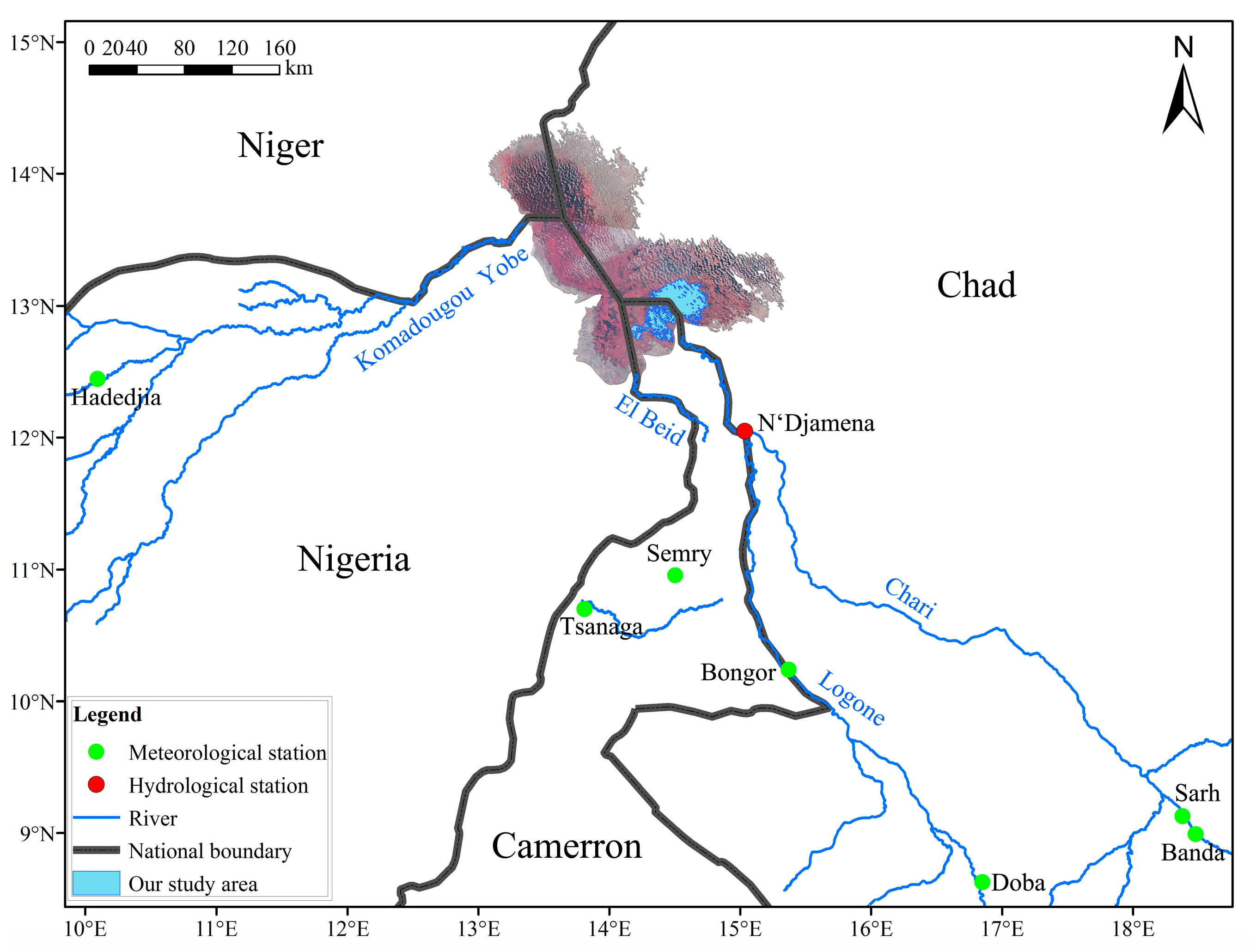
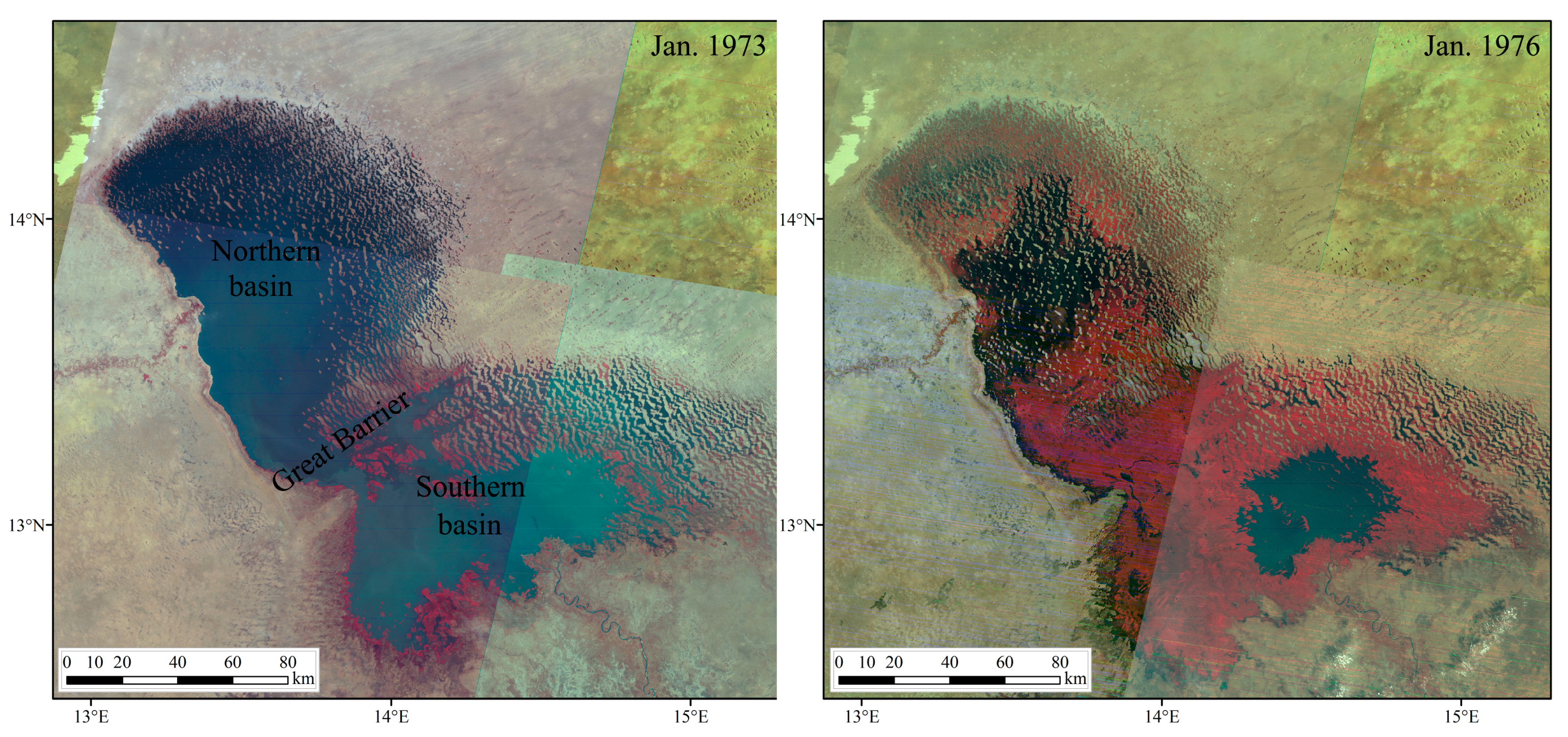


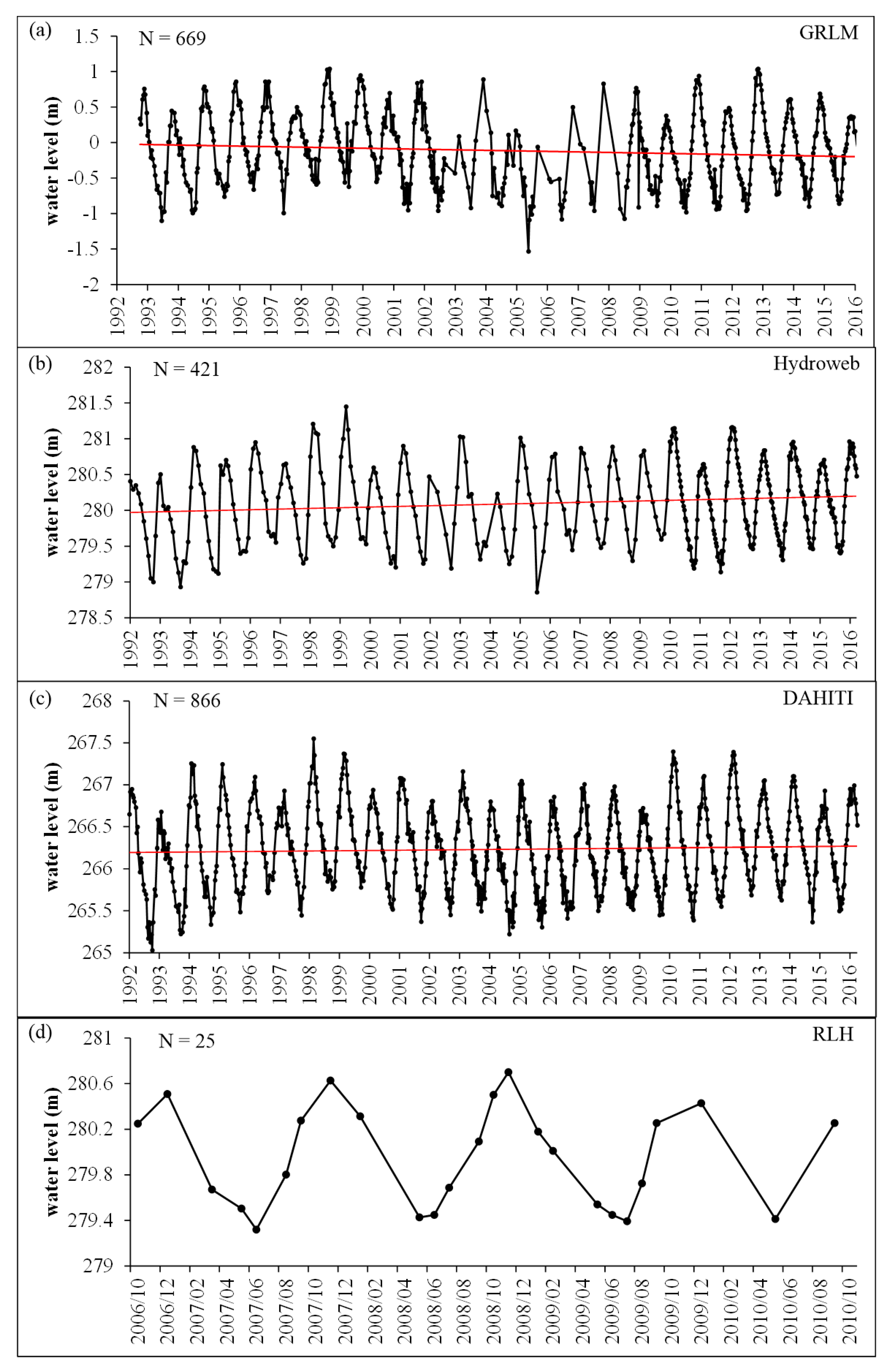
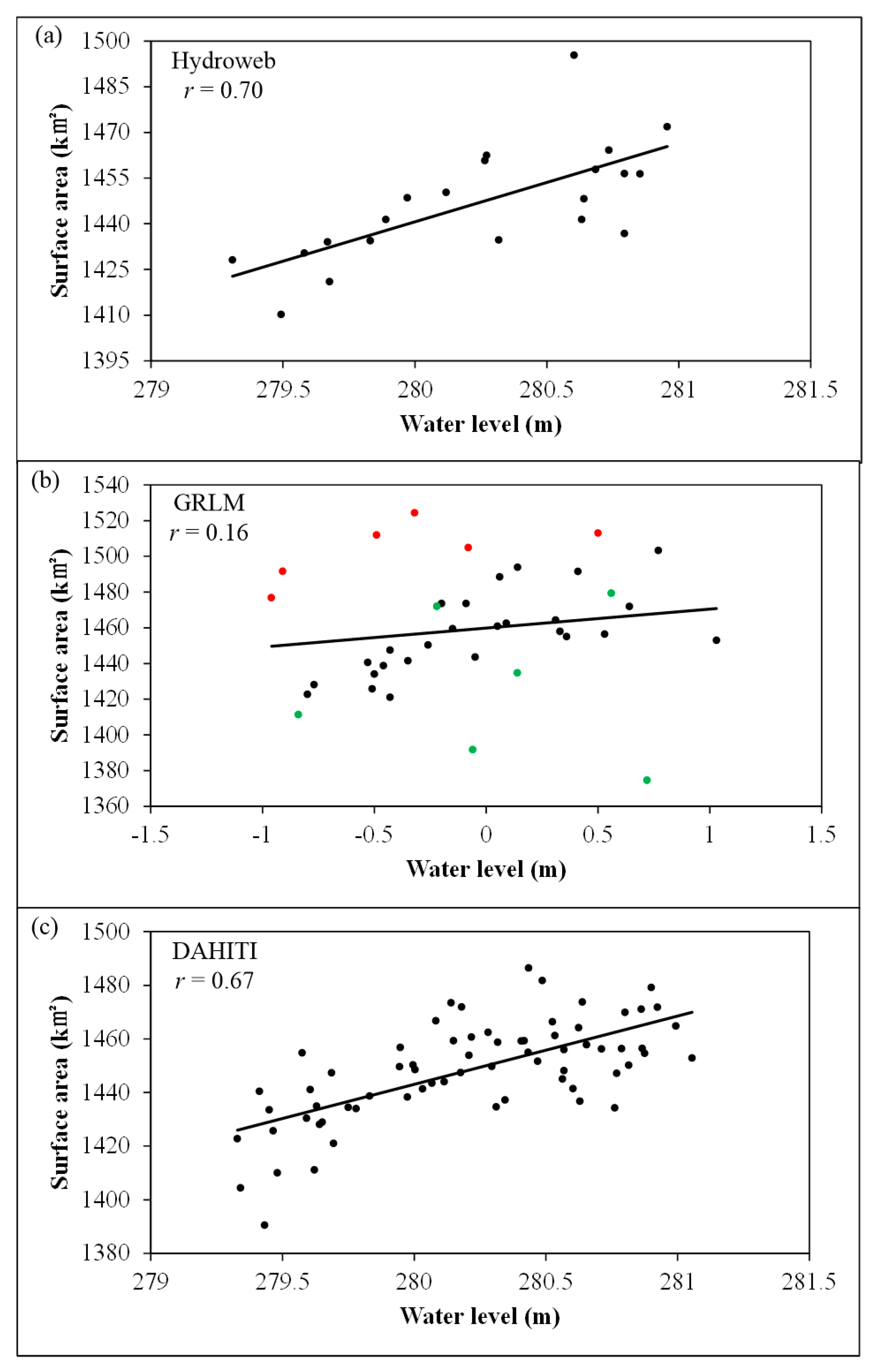
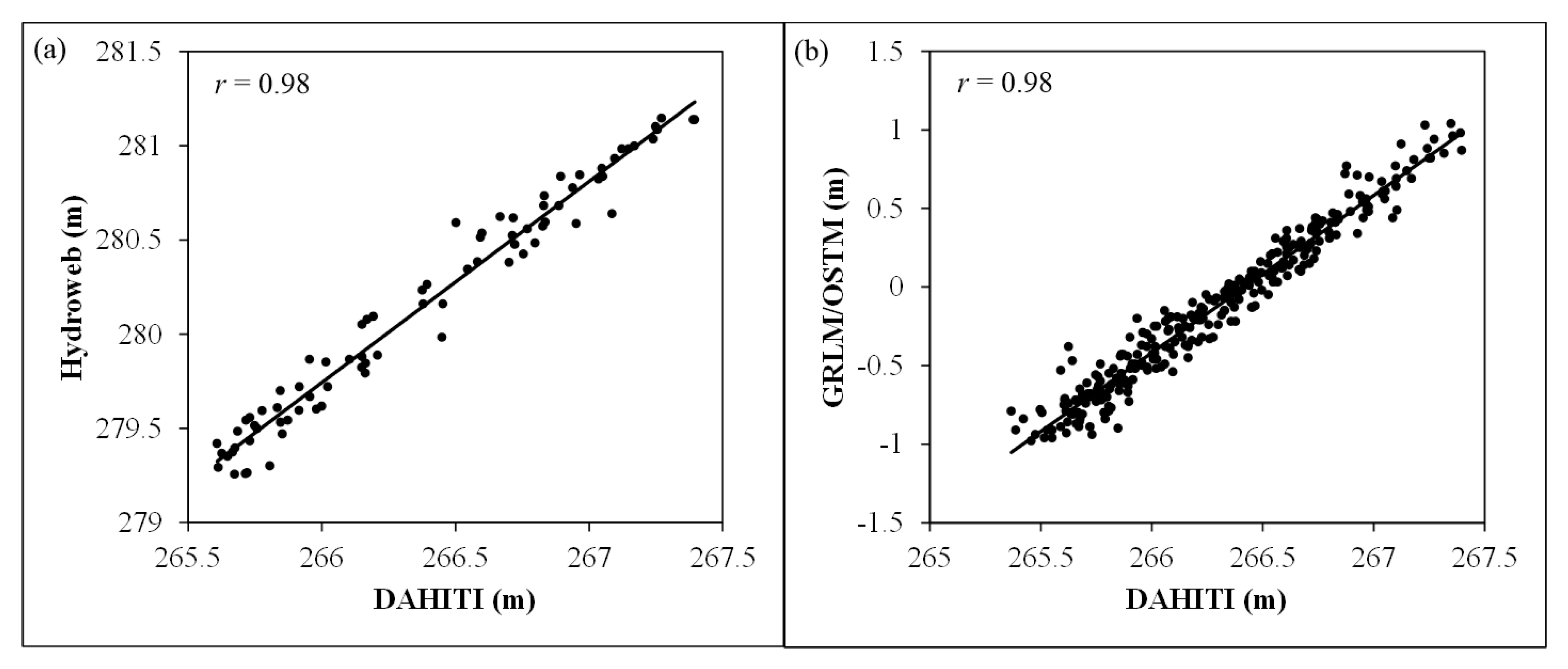
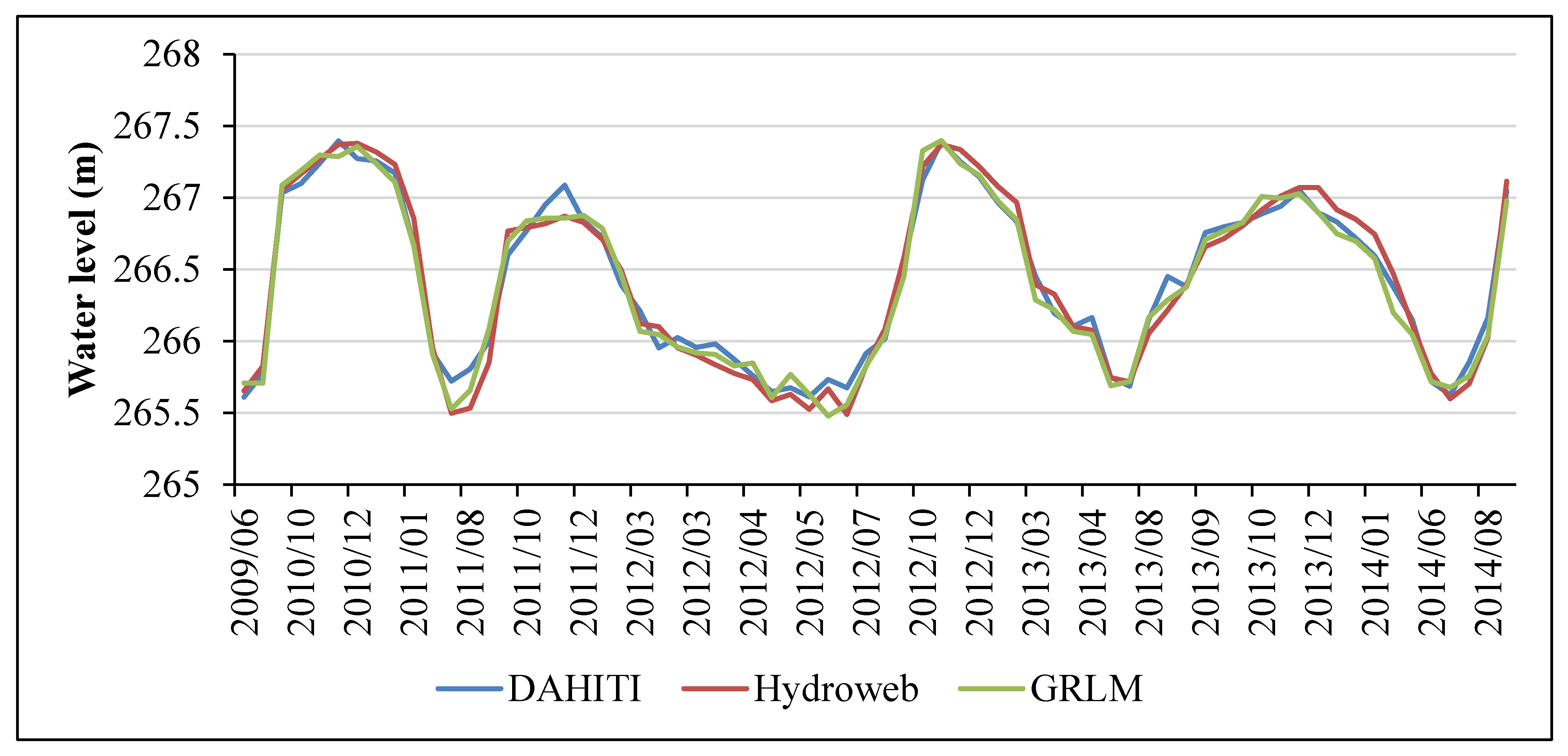


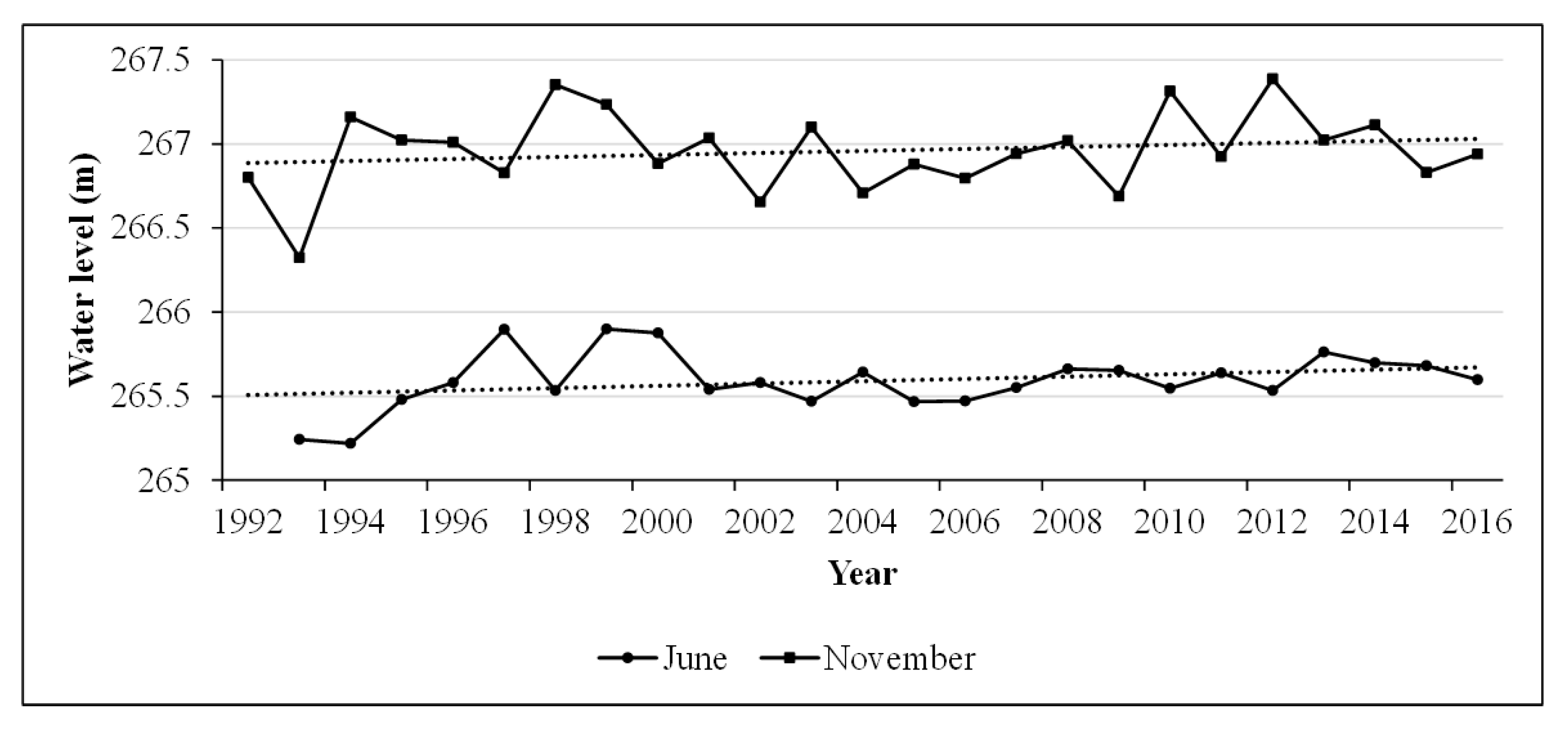
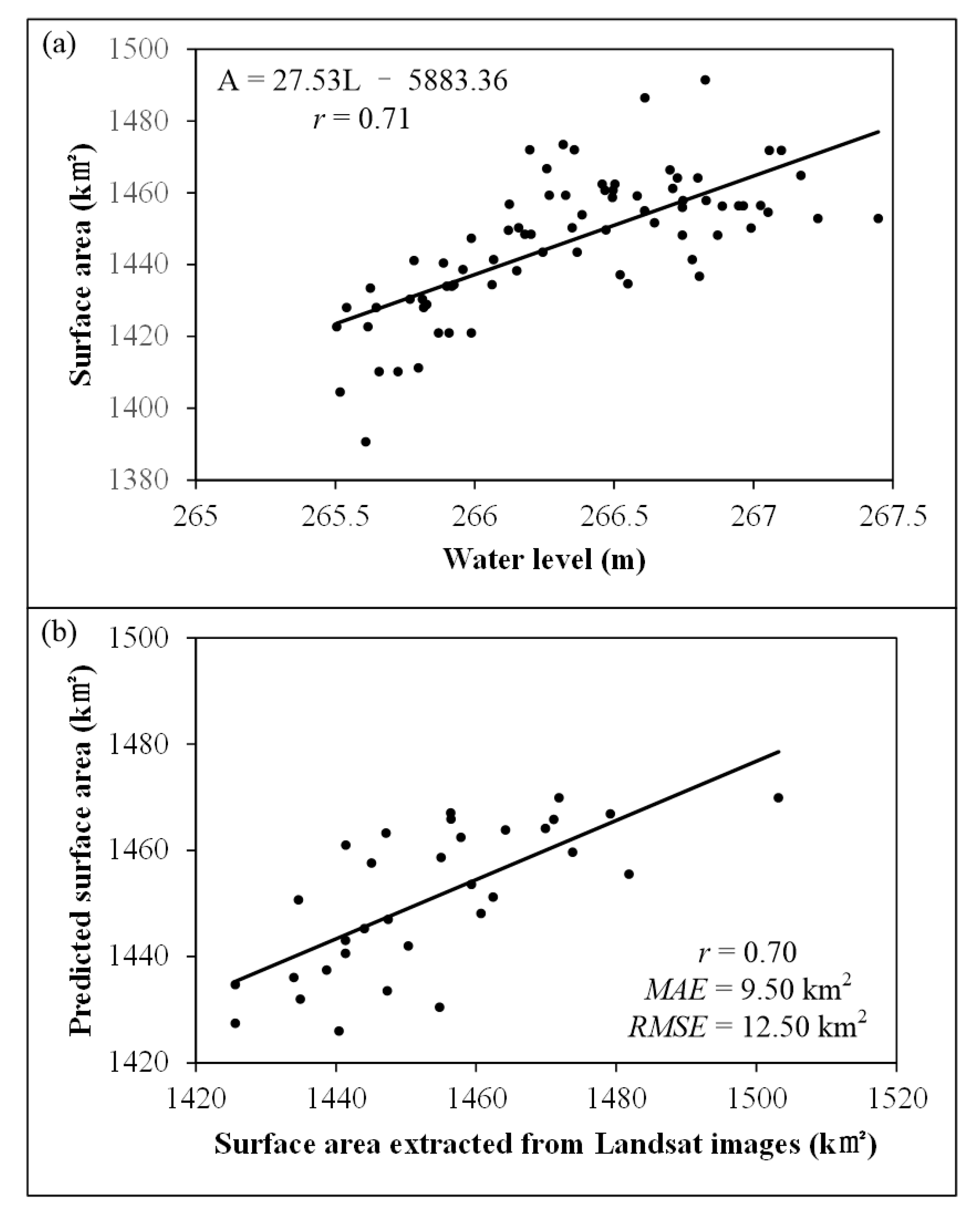


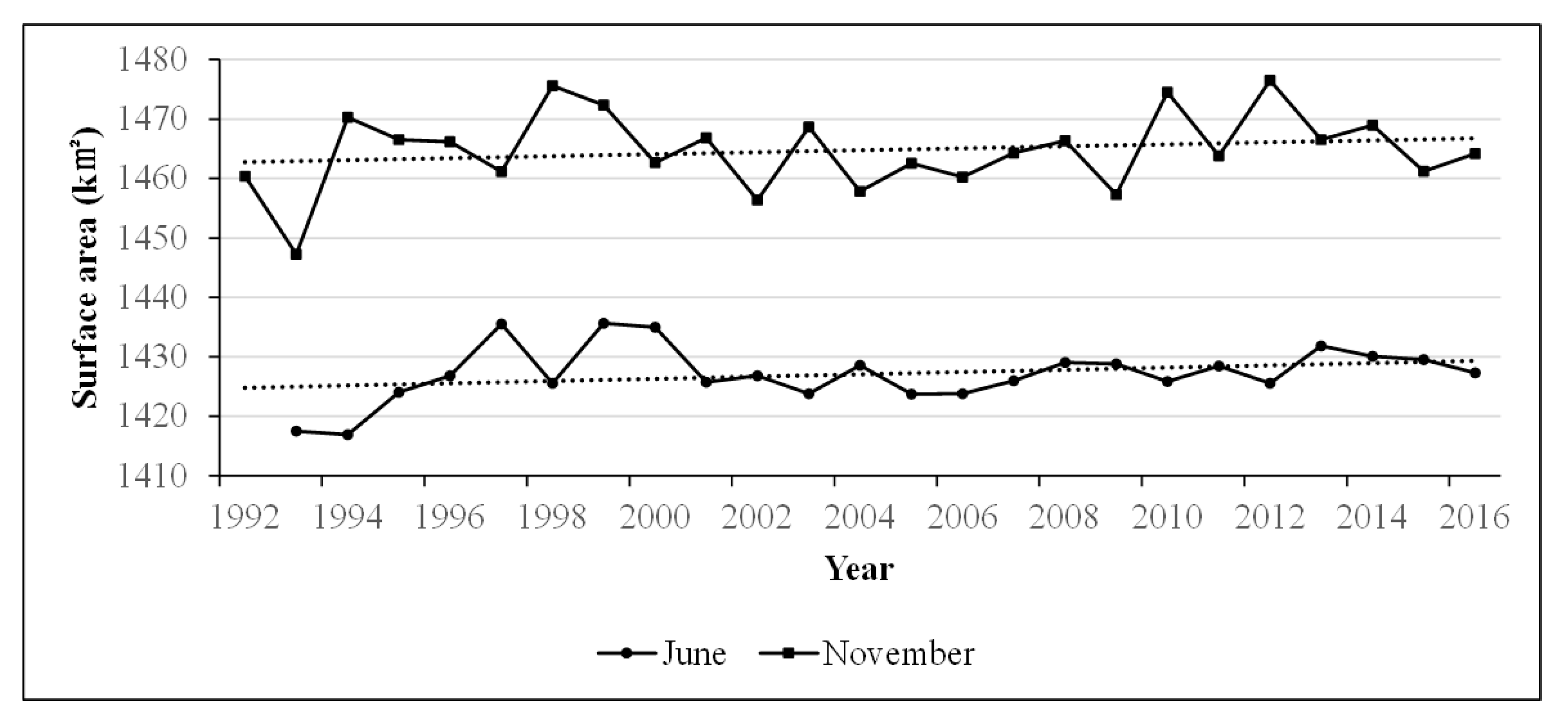
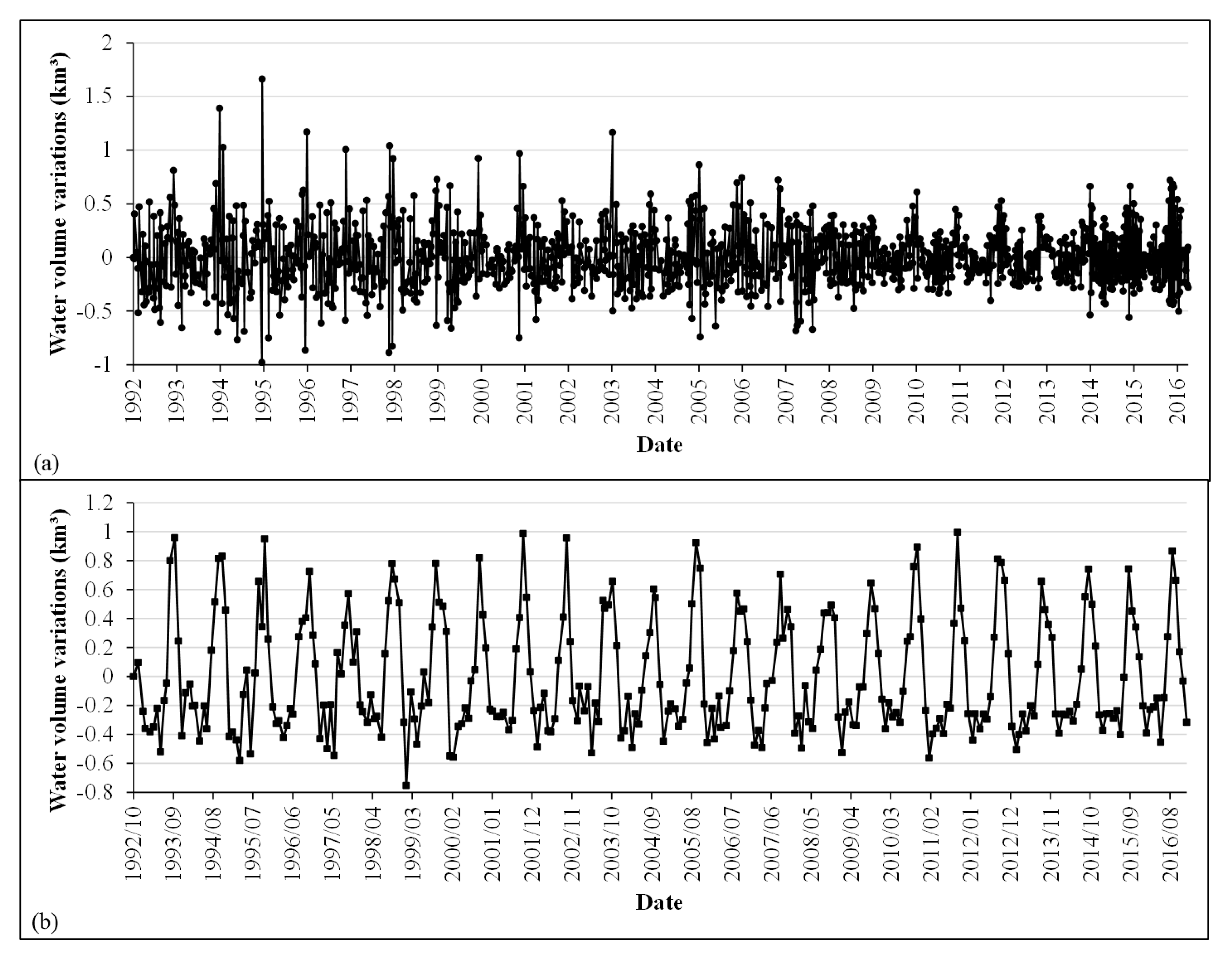


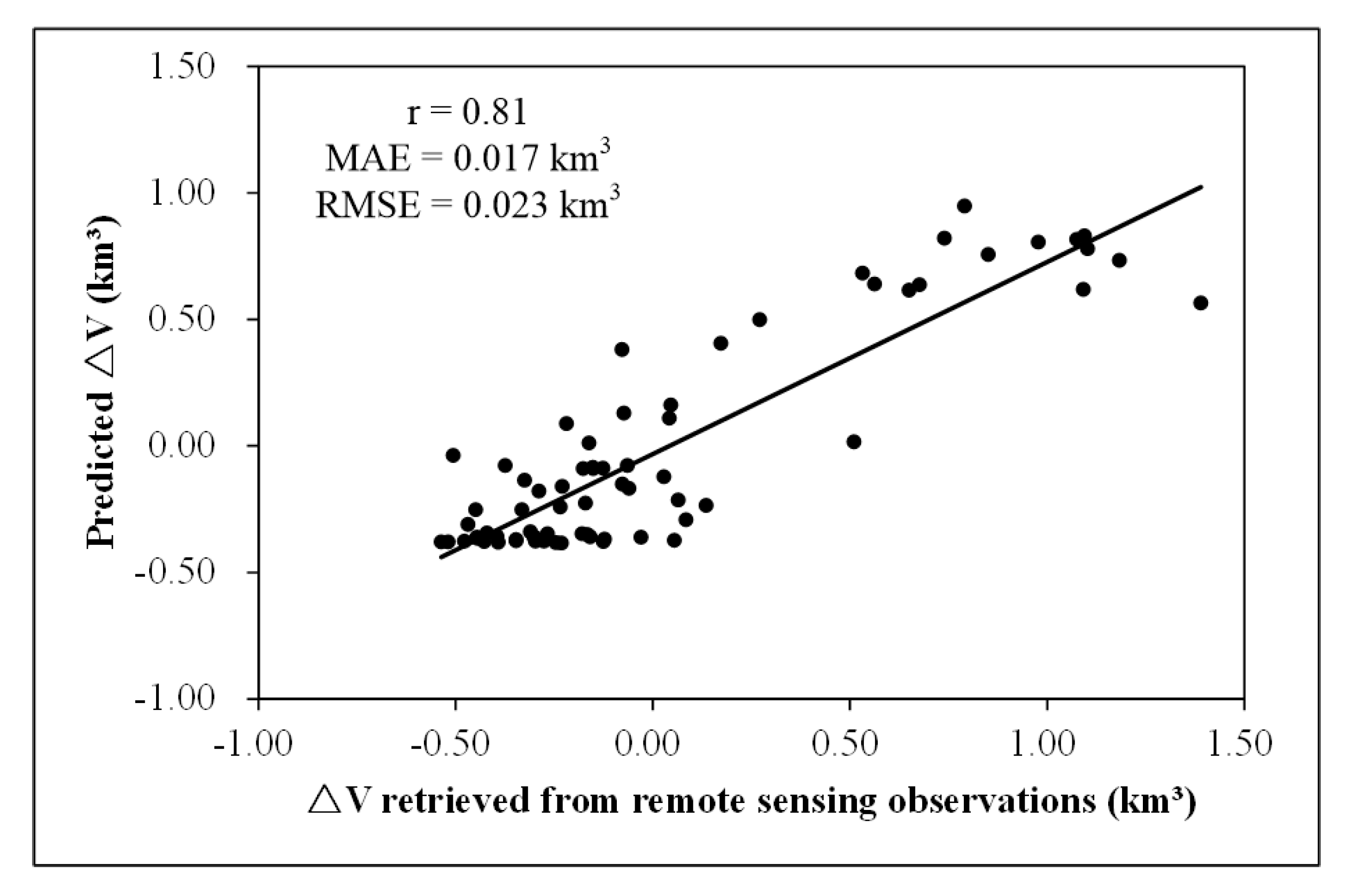
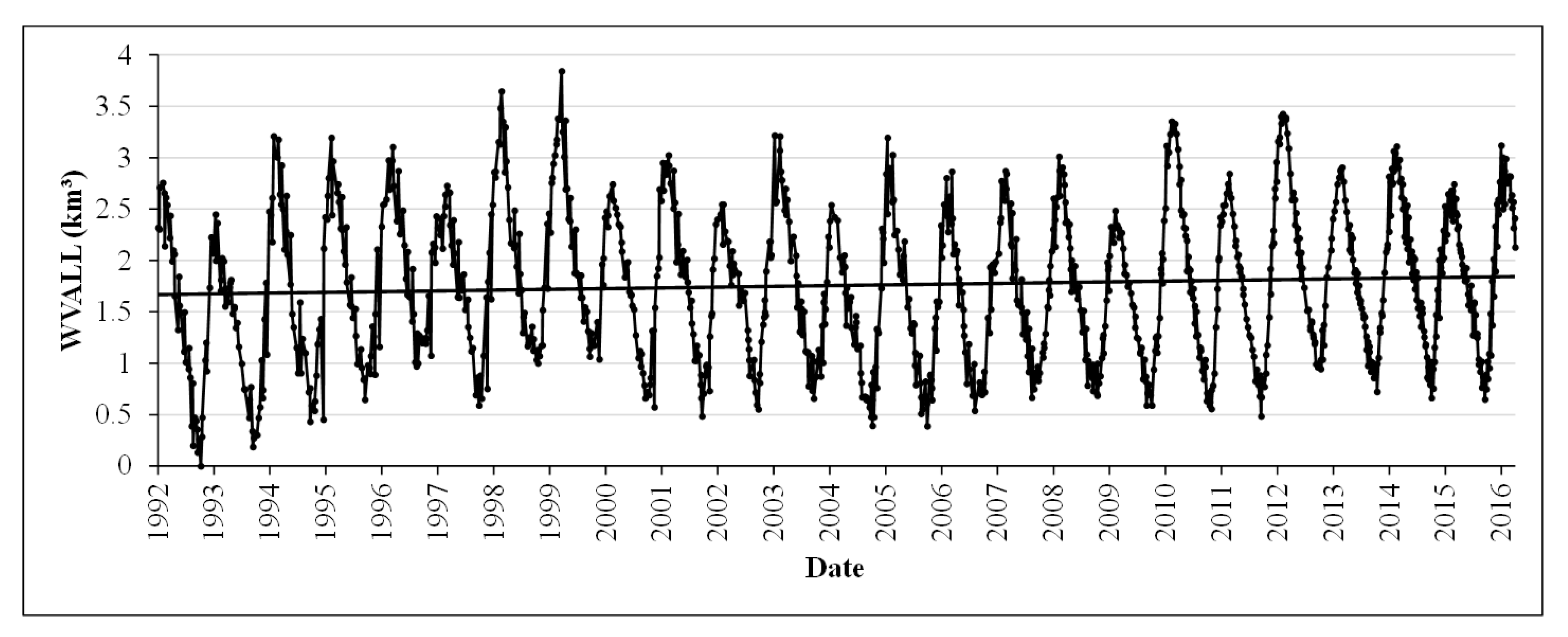
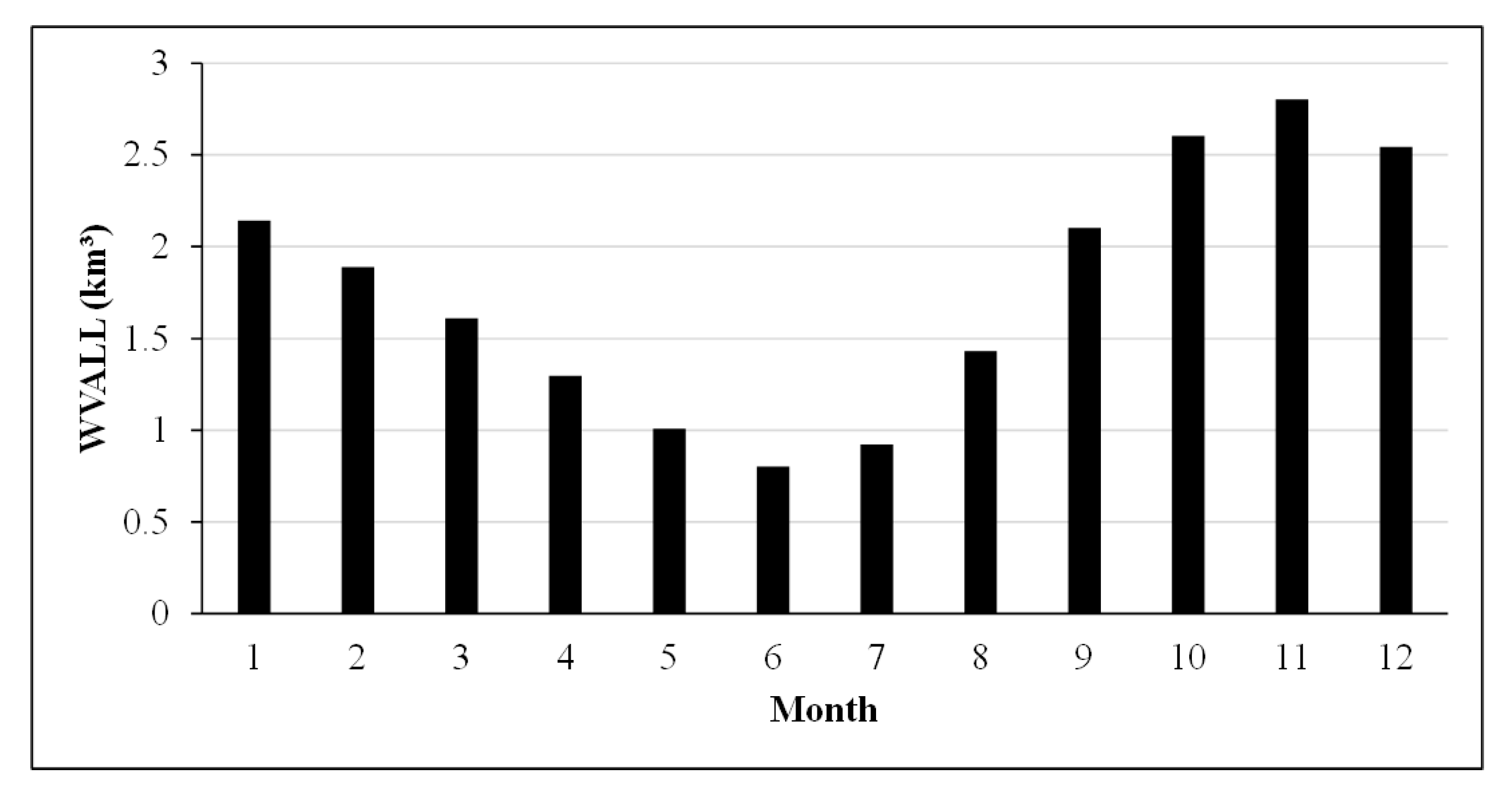
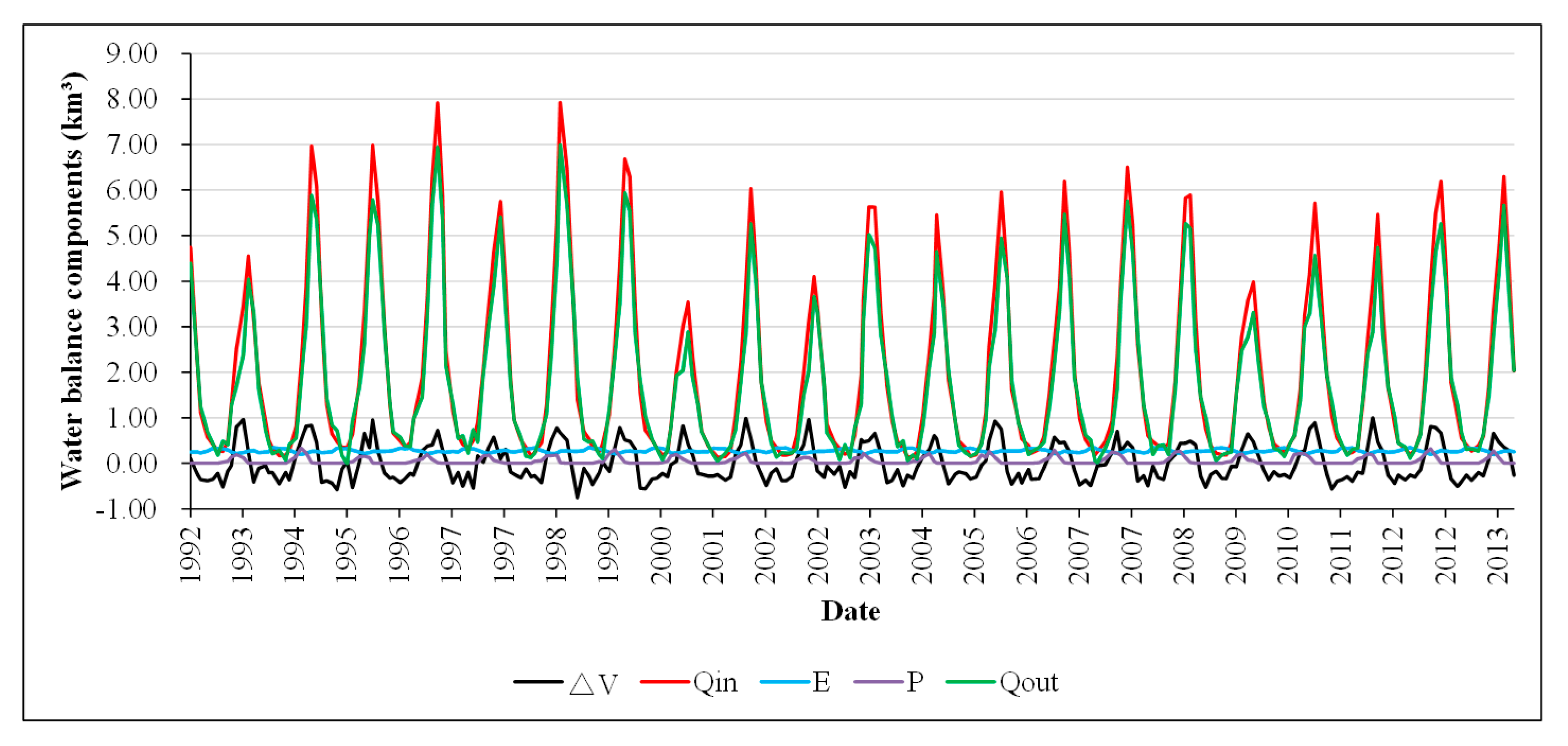
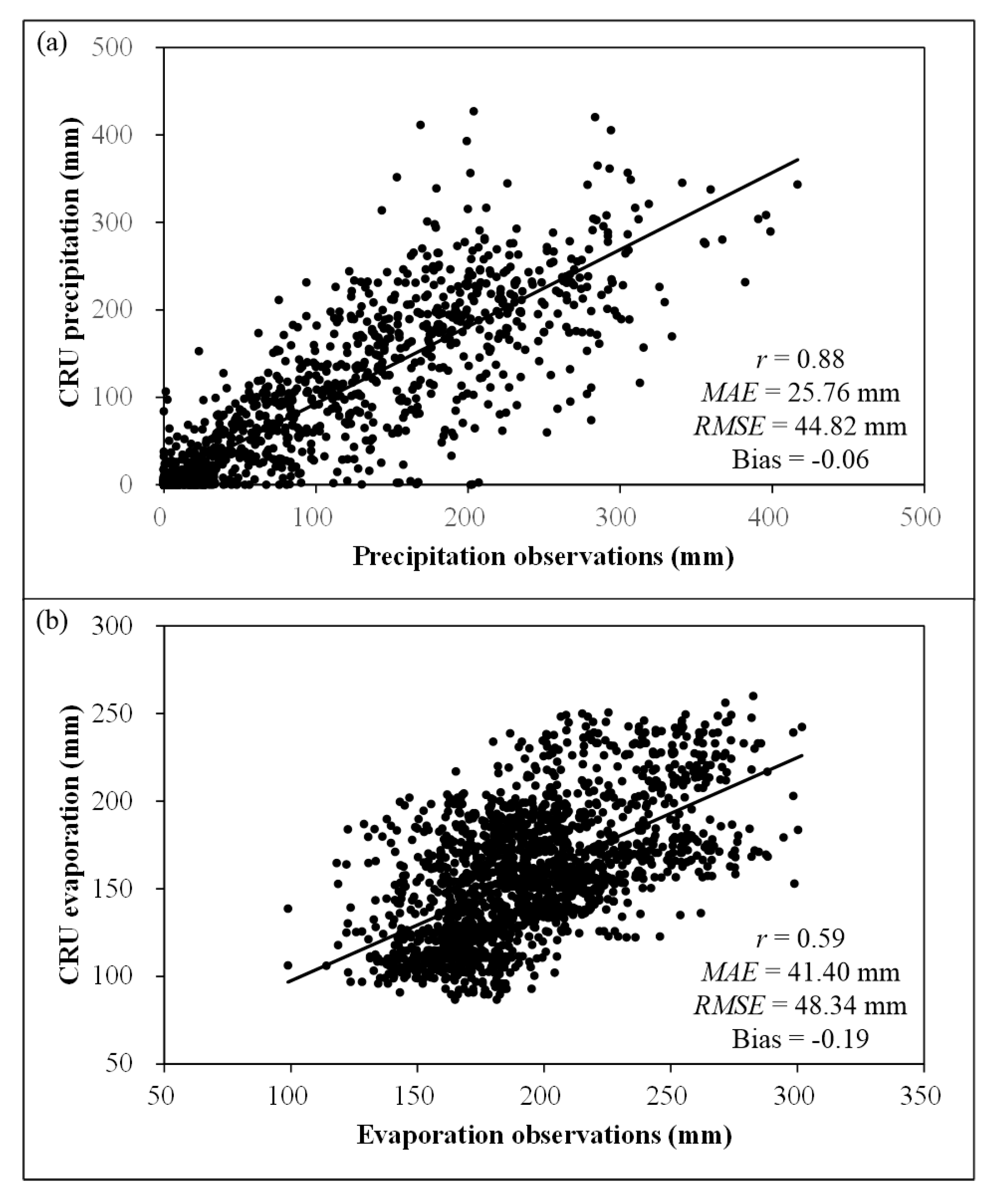
| Month | |||||
|---|---|---|---|---|---|
| 1 | −0.37 | 1.03 | 0.00 | 0.31 | 1.09 |
| 2 | −0.30 | 0.54 | 0.00 | 0.33 | 0.51 |
| 3 | −0.29 | 0.38 | 0.00 | 0.41 | 0.26 |
| 4 | −0.31 | 0.24 | 0.00 | 0.41 | 0.15 |
| 5 | −0.29 | 0.28 | 0.02 | 0.40 | 0.19 |
| 6 | −0.18 | 0.49 | 0.08 | 0.35 | 0.40 |
| 7 | 0.11 | 1.40 | 0.17 | 0.30 | 1.15 |
| 8 | 0.47 | 2.88 | 0.24 | 0.26 | 2.39 |
| 9 | 0.68 | 4.38 | 0.14 | 0.29 | 3.55 |
| 10 | 0.55 | 5.89 | 0.02 | 0.33 | 5.04 |
| 11 | 0.19 | 4.32 | 0.00 | 0.33 | 3.80 |
| 12 | −0.24 | 2.09 | 0.00 | 0.31 | 2.01 |
| Total | 0.01 | 23.91 | 0.67 | 4.03 | 20.54 |
| Study | Time Period | Study Area | ||||
|---|---|---|---|---|---|---|
| LCBC [30] | 1954–1969 | Lake Chad | 7.4 | 48.8 | 44.2 | 2.5 |
| Odada et al. [3] | Pre-1970 | Lake Chad | 6.0 | 43 | 42.89 | 3 |
| Odada et al. [3] | 1971–1990 | Lake Chad | 2.1 | 23.1 | 22.57 | 1.4 |
| LCBC [30] | 1988–2010 | Lake Chad | 1.9 | 22.6 | 21.9 | 1 |
| This study | 1991–2013 | SPLC | 0.67 | 4.03 | 23.91 | 20.54 |
© 2017 by the authors. Licensee MDPI, Basel, Switzerland. This article is an open access article distributed under the terms and conditions of the Creative Commons Attribution (CC BY) license (http://creativecommons.org/licenses/by/4.0/).
Share and Cite
Zhu, W.; Yan, J.; Jia, S. Monitoring Recent Fluctuations of the Southern Pool of Lake Chad Using Multiple Remote Sensing Data: Implications for Water Balance Analysis. Remote Sens. 2017, 9, 1032. https://doi.org/10.3390/rs9101032
Zhu W, Yan J, Jia S. Monitoring Recent Fluctuations of the Southern Pool of Lake Chad Using Multiple Remote Sensing Data: Implications for Water Balance Analysis. Remote Sensing. 2017; 9(10):1032. https://doi.org/10.3390/rs9101032
Chicago/Turabian StyleZhu, Wenbin, Jiabao Yan, and Shaofeng Jia. 2017. "Monitoring Recent Fluctuations of the Southern Pool of Lake Chad Using Multiple Remote Sensing Data: Implications for Water Balance Analysis" Remote Sensing 9, no. 10: 1032. https://doi.org/10.3390/rs9101032




